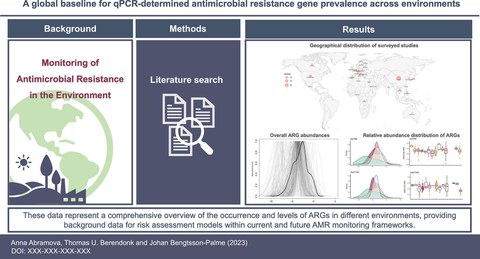21.07.2023
New Publication out !

A global baseline for qPCR-determined antimicrobial resistance gene prevalence across environments
The environment is an important component in the emergence and transmission of antimicrobial resistance (AMR). Despite that, little effort has been made to monitor AMR outside of clinical and veterinary settings. Partially, this is caused by a lack of comprehensive reference data for the vast majority of environments. To enable monitoring to detect deviations from the normal background resistance levels in the environment, it is necessary to establish a baseline of AMR in a variety of settings. In an attempt to establish this baseline level, we here performed a comprehensive literature survey, identifying 150 scientific papers containing relevant qPCR data on antimicrobial resistance genes (ARGs) in environments associated with potential routes for AMR dissemination. The collected data included 1594 samples distributed across 30 different countries and 12 sample types, in a time span from 2001 to 2020. We found that for most ARGs, the typically reported abundances in human impacted environments fell in an interval from 10-5 to 10-3 copies per 16S rRNA, roughly corresponding to one ARG copy in a thousand bacteria. Altogether these data represent a comprehensive overview of the occurrence and levels of ARGs in different environments, providing background data for risk assessment models within current and future AMR monitoring frameworks.
Abramova A, Berendonk TU, Bengtsson-Palme J (2023) A global baseline for qPCR-determined antimicrobial resistance gene prevalence across environments,
Environment International. https://doi.org/10.1016/j.envint.2023.108084
~~~
more publications here
